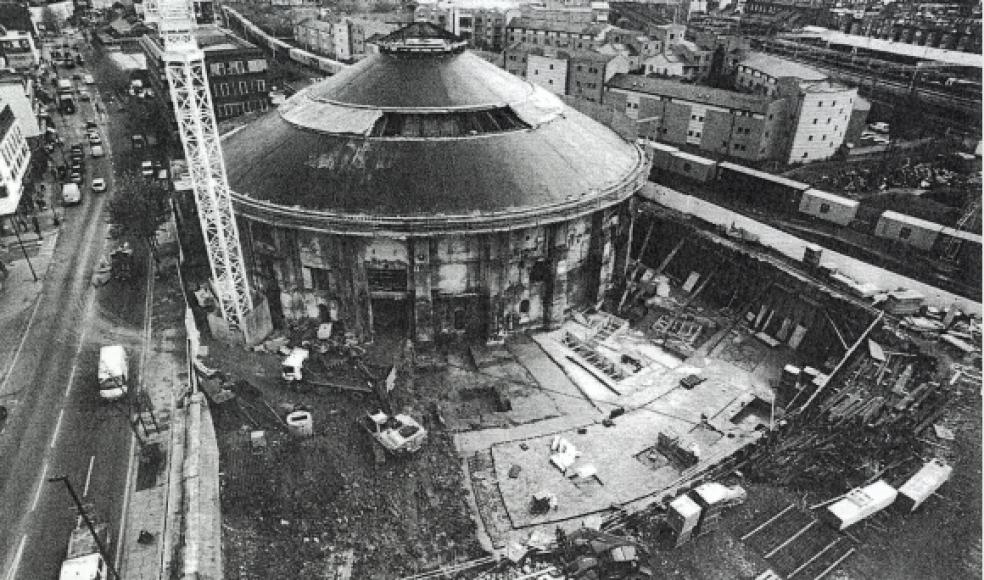Roundhouse
The Roundhouse was an engine shed, built in 1847 to specifications of George Stephenson, housing the engine turntable for the London and Birmingham Railway. The original building is described in The Builder 1847 as: "160 ft in diameter in the clear of the walls. The roof is supported on twenty-four columns at equal distances, and forms a circular 40 ft in radius from the centre of the building". By 1860, it was obsolete and turned into a goods shed. Leased to W. & A. Gilbey Ltd as a liquor store in 1869, it is thought that the existing wooden balcony was added at this time.
The history of the Roundhouse as a theatre coincided with the playwright Arnold Wesker's dream of an arts community theatre (a base for his Centre 42). The lease for the building came up for sale in 1964, was acquired by Selincourt & Sons, whose Managing Director Louis Mintz, a patron of the arts, donated it to the Roundhouse Theatre Trust, set up in 1966, with Wesker as Artistic Director. By 1967 staircases had been built, the building repaired, and a licence granted for pop concerts. Plans were drawn up for internal reconstruction to include rehearsal rooms, gymnasium, and various areas for artistic and social use, but these were not realised. The first drama presentations ran at a huge loss, resulting in Wesker's resignation from the project. The discontinuation of pop concerts should have been reviewed, as they provided sufficient income to support other productions, created an awareness of the building amongst young people, and were within the original concept of social/community use.
In 1973, the vaults were excavated and new front entrance stairs built. In 1974 a new office block was built on adjoining land by benefactor Mintz, which housed dressing rooms, workshops and storage space for the theatre. The following year the building was closed for steel reinforcements to the floor which made room for the studio Theatre Downstairs. That year, under Thelma Holt's direction, the interior was redesigned for theatre-in-the-round by architects Levitt Bernstein and Richard Negri, as a London base for his Manchester Royal Exchange, reducing the capacity from 940 to 600. It was regularly used by that Company as a London venue until Holt gave up in 1982, when the Round House closed. In 1988 it became a black arts centre for a while.
A proposal to house the British Architectural Library in the building never came to fruition and the Roundhouse was purchased by the Norman Trust in 1998.
The Roundhouse closed in 2004 for a two year, £28 million redevelopment which involved the installation of flexible seating, soundproofing and restoration of the circular glazed roof lights. In addition, a new foyer wing was attached to the North side of the building to house the box office, bar, cafe and an art gallery. The redevelopment also saw the construction of the Paul Hamlyn Roundhouse Studios, a creative centre for 11-25 year olds and a 130 seat studio theatre. The Roundhouse reopened in June 2006.
- 1988 - 1982: continuing
Further details
- 1847 Owner/Management: London & Birmingham Railway
- 1847 Design/Construction: as engine shedGeorge Stephenson- Architect
- 1869 Owner/Management: W A Gilbey, lessees
- 1964 Owner/Management: Round House Theatre Trust, lessee
- 1967 Alteration: Allen & Rich, theatre fit-upBickerdyke- Architect
- 1973 - 1974 Alteration: Array adjoining developmentRichard Seifert- Architect
- 1977 Alteration: theatre-in-the-round fit-upLevitt Bernstein- ArchitectRichard Negri- Designer
- 1977 Design/Construction:D K Jones- Consultantacoustic dome and other works to improve sound
- 1983 Owner/Management: Camden Council (with GLC), freeholder
- 1988 - 1982 Use: continuing
- 1996 - 1998 Owner/Management: The Norman Trust
- 1998 Owner/Management: The Roundhouse Trust
- 2004 - 2006 Alteration: redevelopment and restoration; construction of creative centreJohn McAslan Partners- Architect
- CapacityLaterDescription1967: 960
1977: 600 - CapacityCurrentDescription2013: Seated: 1500
2013: Standing: 3000
- ListingII*
